
- Home Page
- Accepted
Paintings & Copies - Doubtful
Attributions - Doubtful Textual References
- Alternative
Titles - Collectors &
Museums - Bibliography
- Search Abecedario
- Watteau &
His Circle
A Village Plundered by the Enemy
Entered August 2019; revised January 2020

Presumed lost
Oil on canvas
30.5 x 40 cm
ALTERNATIVE TITLES
An Army Plundering a Village
A Party of Soldiers Plundering a Village
Soldiers Plundering
Soldiers Plundering a Village
RELATED PRINTS
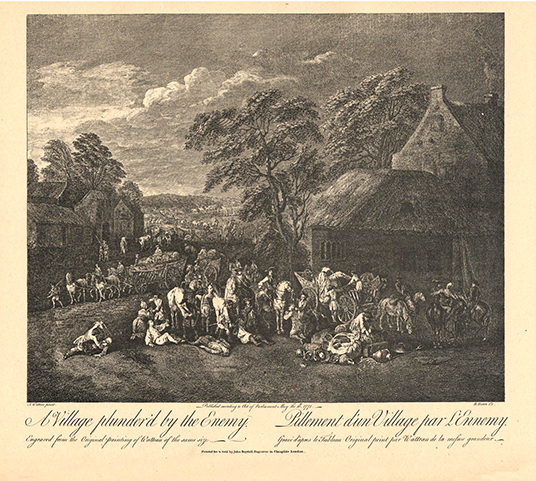
Bernard Baron after Watteau, A Village Plundered by the Enemy, 1748, engraving.
A Village Plundered by the Enemy and its pendant, The Country People's Revenge, were engraved in reverse by Bernard Baron in 1748. The prints were reissued by James Boydell in 1771.
PROVENANCE
This painting and its pendant must have been in London when they were engraved there in 1748.
London, collection of “a person of fashion.” His or her sale, London, May 10, 1782, lot 14: “A. Watteau . . . An Army plundering a Village.” Sold for £1.16.0 according to an annotated copy of the sale catalogue at the Frick Art Reference Library, New York.
London, collections of Demasso and Parys. Their sale, London, sale, February 6, 1790, lot 51: “Watteaux . . . Soldiers Plundering.” Sold for £5.15 according to an annotated copy of the sale catalogue at the Frick Art Reference Library, New York; sold for £5.5 livres to Hughes according to the Getty Provenance Index.
London, collection of Charles Alexandre de Calonne (1734-1802; statesman). His sale and others, London, March 28, 1795, lot 34: “Watteaux . . . A Party of Soldiers plundering a Village. Shows the universality of the genius of the artist, painted with great spirit, and finely coloured.”
London, Christie’s, June 18, 1805, lot 12: “Watteau . . . Soldiers plundering a Village.” Sold for £1.10.
SELECT BIBLIOGRAPHY
Hédouin, “Watteau” (1845), cat. 127.
Hédouin, Mosaïque (1856), cat. 129.
Goncourt, L’Art au XVIIIème siècle (1860), 56.
Goncourt, Catalogue raisonné (1875), cat. 60.
Mollet, Watteau (1883), 62.
Josz, Watteau (1904), 55, 191.
Dacier, Vuaflart, and Hérold, Jean de Jullienne et les graveurs (1921-29), 1: 94-95; 2: 143; 3: cat. 290.
Réau, “Watteau” (1928), cat.4 6.
Adhémar, Watteau (1950), cat. 278.
Mathey, Watteau, peintures réapparues (1959), 24-25, 67, 73.
Macchia and Montagni, L’opera completa di Watteau (1968), cat. 5o D.
Glorieux, “L’Angleterre et Watteau” (2006), 68, 74.
REMARKS
When A Village Plundered by the Enemy was engraved in 1748, it was with its pendant, The County People’s Revenge. However, the two works were separated by at least 1782, the year that A Village Plundered was sold separately. It then appeared sporadically at London auctions until 1805, after which it fell entirely from sight. Unlike The County People’s Revenge, which was discovered by Wildenstein just after World War II, The Village Plundered seems not to have survived.
There has been little critical confidence or interest in A Village Plundered by the Enemy and its pendant, despite that fact that both compositions were engraved under Watteau’s name by Bernard Baron, the French print maker based in London who had befriended Watteau during his stay in the English capital. Even though the prints declare Watteau’s authorship, the compositions do not look like works by the painter of fêtes galantes. To a degree this is understandable. Whereas the themes of brigands attacking a village and villagers fighting back are common themes in Netherlandish seventeenth-century painting, this was an area that Watteau seems to have shunned. While he did paint military subjects as a young artist, they were scenes of encampments or troops on the move—relatively peaceful scenes rather than depictions of violence and mayhem. Thus it is not surprising that many critics have been suspicious of these two pictures, unparalleled in Watteau’s oeuvre. Adhémar classified the pendants as doubtful works and attributed them to Jérôme François Chantereau, a Watteau satellite (but one whose style is unrelated), or another follower of Watteau.
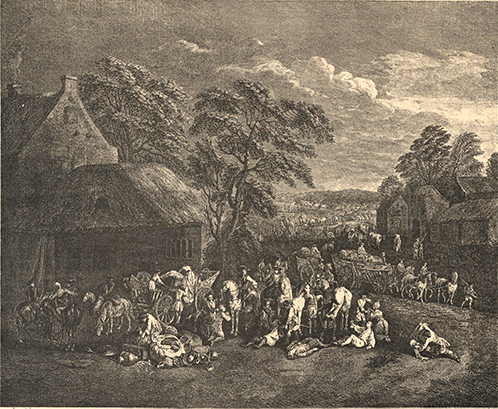
Bernard Baron after Watteau, A Village Plundered by the Enemy, engraving (here reversed to the original direction of the painting).
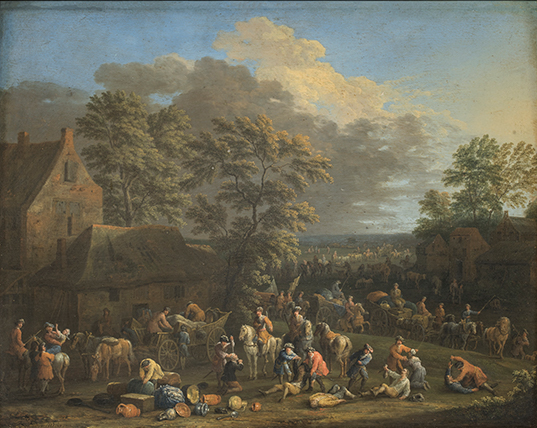
Jan Baptist van der Meiren, Pillaging of a Village, oil on panel, 31 x 47.5 cm. Rome, Galleria nazionale d'arte antica, courtesy Biblioteca Hertziana, Istituto Max Planck per la storia dell’arte / Enrico Fontolan.
Despite the reappearance of The County People’s Revenge after two centuries of obscurity, most contemporary scholars have entirely ignored the issues and the paintings surrounding these pendants. The key to understanding them was found by Karl T. Parker in the Galleria nazionale in Rome, where he came upon a similar pair of paintings by the minor Dutch artist Jan Baptist van der Meiren (1664-1736).
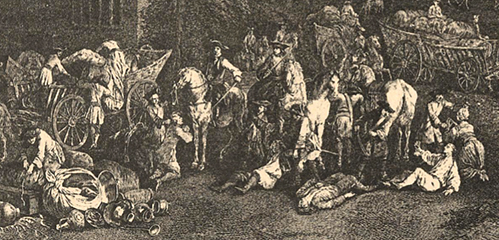
Bernard Baron after Watteau, A Village Plundered by the Enemy (detail).
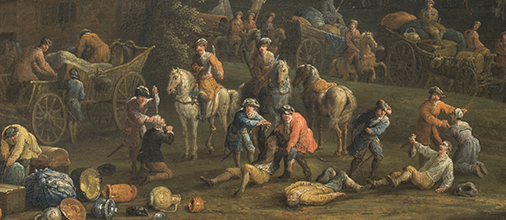
Jan Baptist van der Meiren, Pillaging of a Village, (detail).
The panels in the Galleria nazionale cannot be the exact ones that Watteau copied because they had been in Rome since the early eighteenth century, and thus would not have been accessible to Watteau. However, Van der Meiren evidently executed more than one set and Watteau would have copied such a second set. This explains why there are so many differences between the Galleria nazionale paintings and Watteau’s. Some of the two artists’ figures are essentially identical, but many are only comparable.
In all likelihood Watteau’s pendants were executed early in his career, when he worked for commercial painters on the Pont Notre Dame. In his chronology of Watteau’s works, Mathey dated A Village Plundered by the Enemy to c. 1710. Cailleux proposed a date of late 1708-early 1709.